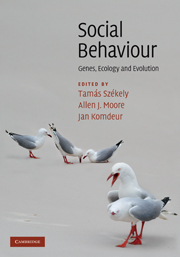Book contents
- Frontmatter
- Contents
- List of contributors
- Introduction: The uphill climb of sociobiology: towards a new synthesis
- Profile: Undiminished passion
- Part I Foundations
- Part II Themes
- Part III Implications
- 16 Personality and individual social specialisation
- Profile: Behavioural ecology, why do I love thee? Let me count the reasons
- 17 Molecular and genetic influences on the neural substrate of social cognition in humans
- Profile: Anonymous (and other) social experience and the evolution of cooperation by reciprocity
- 18 Population density, social behaviour and sex allocation
- Profile: Social theory based on natural selection
- 19 Social behaviour and speciation
- Profile: Look to the ants
- 20 Social behaviour in conservation
- Profile: The handicap principle and social behaviour
- 21 Prospects for research in social behaviour: systems biology meets behaviour
- Species index
- Subject index
- References
19 - Social behaviour and speciation
Published online by Cambridge University Press: 05 June 2012
- Frontmatter
- Contents
- List of contributors
- Introduction: The uphill climb of sociobiology: towards a new synthesis
- Profile: Undiminished passion
- Part I Foundations
- Part II Themes
- Part III Implications
- 16 Personality and individual social specialisation
- Profile: Behavioural ecology, why do I love thee? Let me count the reasons
- 17 Molecular and genetic influences on the neural substrate of social cognition in humans
- Profile: Anonymous (and other) social experience and the evolution of cooperation by reciprocity
- 18 Population density, social behaviour and sex allocation
- Profile: Social theory based on natural selection
- 19 Social behaviour and speciation
- Profile: Look to the ants
- 20 Social behaviour in conservation
- Profile: The handicap principle and social behaviour
- 21 Prospects for research in social behaviour: systems biology meets behaviour
- Species index
- Subject index
- References
Summary
Overview
Speciation results from the evolution of traits that inhibit reproduction between populations. This chapter discusses theoretical and empirical studies that relate to how social behaviour influences those reproductive barriers. Behaviour can influence prezygotic isolation by causing non-random mating or non-random fertilisation. Learning can affect mate recognition through cultural transmission of mate advertisement signals and sexual imprinting. Behaviour can also contribute to reproductive isolation if hybrids are discriminated against as mates or if female re-mating influences fertilisation success.
A general theory of speciation does not exist, but a variety of models have been developed to describe how selection can favour speciation in particular situations. Theory suggests that sexual selection, in particular, should be a diversifying force. However, among vertebrates sexual selection by female choice has favoured expression of condition-dependent traits, which are typically not reliable for species recognition. Better examples of sexually selected traits functioning in both mate-choice and species-recognition contexts can be found among some insects, such as crickets. The best examples of sexual selection influencing speciation in vertebrates come from cases of sexual imprinting in birds where offspring learn species-recognition cues in the nest.
Sexual selection can also operate after mating by sperm competition or cryptic female choice. Either or both of these mechanisms likely contribute to conspecific sperm precedence, which may result in reproductive isolation after mating. Sexually antagonistic coevolution has the potential to drive speciation in systems with sexual conflict.
- Type
- Chapter
- Information
- Social BehaviourGenes, Ecology and Evolution, pp. 491 - 515Publisher: Cambridge University PressPrint publication year: 2010
References
- 5
- Cited by



